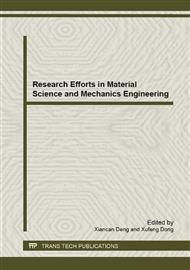[1]
Wen, D.S., Pan, J.S., Lu, S.J., Wen, J., Zhu, X.J., Li, H.Q., Xie, Q.W., 2004. A new method (technique) to improve the performance index of axial piston pumps. Fluid Power Transmission and Control. (5): 5-9.
Google Scholar
[2]
Ai,Q.L., Zhou, H., Yang, H.Y., 2005. Development and Simulation of Lubrication Test System for Port Plate-cylinder Block in Axial Piston Pump. Proceedings from the Sixth International Conference on Fluid Power Transmission and Control, ICFP'2005, pp.589-593.
Google Scholar
[3]
Wang. X, Yamaguchia, A, 2002. Characteristics of hydrostatic bearing/seal parts for water hydraulic pumps and motors. Part 2: On eccentric loading and power losses. Tribology International, 35(7), pp.435-442.
DOI: 10.1016/s0301-679x(02)00024-5
Google Scholar
[4]
Johansson, A., Palmberg, J., 2002. Quieter hydraulic system-design considerations. Proceedings from 5th JFPS International Symposium on Fluid Power, pp.799-804.
DOI: 10.5739/isfp.2002.799
Google Scholar
[5]
Nie, S.L., Huang, G.H., Li, Y.P., 2006. Tribological study on hydrostatic slipper bearing with annular orifice damper for water hydraulic axial piston motor. Tribology International, 39(11): 1342-1354.
DOI: 10.1016/j.triboint.2005.10.007
Google Scholar
[6]
Michael, R., Melief, H. M. Development of a New High-pressure Piston Pump Test for Hydraulic Fluid Qualification. Proceedings from 5th JFPS International Symposium on Fluid Power, 2002. pp.245-250.
DOI: 10.5739/isfp.2002.245
Google Scholar
[7]
Glavatskih, S.B., Uusitalo, O., Spohn, D.J. Simultaneous monitoring of oil film thickness and temperature in fluid bearings. Tribology International, 2001, 34(12): 853-857.
DOI: 10.1016/s0301-679x(01)00086-x
Google Scholar
[8]
Lee S.Y., Hong Y.S., 2004. Effect of CrSiN thin film coating on the improvement of the low-speed torque efficiency of a hydraulic piston pump. Surface & Coatings Technology. 202(4-7): 1129-1134.
DOI: 10.1016/j.surfcoat.2007.07.063
Google Scholar
[9]
Lu, X., Wong, K. C., Wong, P. C., Mitchell, K. A. R., Cotter, J., Eadie, D. T., 2006. Surface characterization of polytetrafluoroethylene (PTFE) transfer films during rolling-sliding tribology tests using X-ray photoelectron spectroscopy. WEAR. 261(10): 1155-1162.
DOI: 10.1016/j.wear.2006.03.020
Google Scholar
[10]
Le, H.R., Sutcliffe, M.P.F., 2002. Measurements of friction in strip drawing under thin film lubrication. Tribology International, 35 (2): 123-128.
DOI: 10.1016/s0301-679x(01)00104-9
Google Scholar
[11]
Liu, H.L., Ke, J., Wang, C.Z., Yu L.Y., 2006. Lubrication characteristics of the water hydraulic sliding shoe pairs. Chinese Journal of mechanical engineering. 42 (3): 36-39, 45.
DOI: 10.3901/jme.2006.03.036
Google Scholar
[12]
Xu, Y.M., 1987. Oil Film Theory and Friction Pair Design for Hydraulic Pump and Motor. China Machine Press, Beijing, pp.133-140.
Google Scholar
[13]
Mandal, N. P., Saha, R., Sanyal, D. Effects of flow inertia modeling and valve-plate geometry on swash-plate axial-piston pump performance. PROCEEDINGS OF THE INSTITUTION OF MECHANICAL ENGINEERS PART I-JOURNAL OF SYSTEMS AND CONTROL ENGINEERING. 2012, 226(14): 451-465.
DOI: 10.1177/0959651811426508
Google Scholar
[14]
Manring, Noah D., Mehta, Viral S. Physical Limitations for the Bandwidth Frequency of a Pressure Controlled, Axial-Piston Pump. JOURNAL OF DYNAMIC SYSTEMS MEASUREMENT AND CONTROL-TRANSACTIONS OF THE ASME. 2011, 133(6).
DOI: 10.1115/1.4004056
Google Scholar
[15]
Ai,Q.L., Zhou, H., Yang, H.Y., 2005. Research on micron electrohydraulic position feedback control system. Journal of Zhejiang University: Engineering Science. 39(12): 1937-(1940).
Google Scholar


